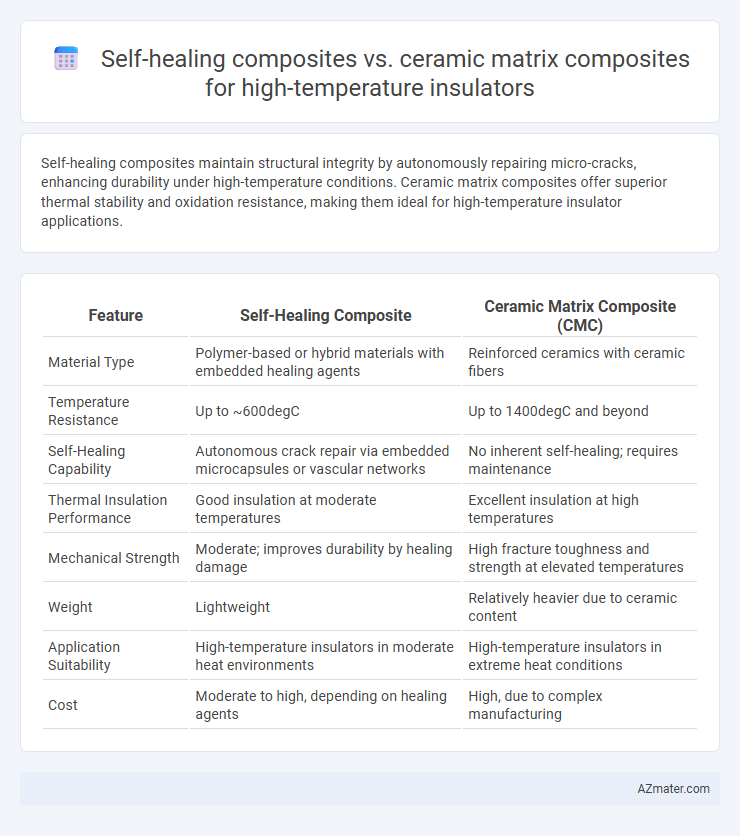Self-healing composites maintain structural integrity by autonomously repairing micro-cracks, enhancing durability under high-temperature conditions. Ceramic matrix composites offer superior thermal stability and oxidation resistance, making them ideal for high-temperature insulator applications.
Table of Comparison
| Feature | Self-Healing Composite | Ceramic Matrix Composite (CMC) |
|---|---|---|
| Material Type | Polymer-based or hybrid materials with embedded healing agents | Reinforced ceramics with ceramic fibers |
| Temperature Resistance | Up to ~600degC | Up to 1400degC and beyond |
| Self-Healing Capability | Autonomous crack repair via embedded microcapsules or vascular networks | No inherent self-healing; requires maintenance |
| Thermal Insulation Performance | Good insulation at moderate temperatures | Excellent insulation at high temperatures |
| Mechanical Strength | Moderate; improves durability by healing damage | High fracture toughness and strength at elevated temperatures |
| Weight | Lightweight | Relatively heavier due to ceramic content |
| Application Suitability | High-temperature insulators in moderate heat environments | High-temperature insulators in extreme heat conditions |
| Cost | Moderate to high, depending on healing agents | High, due to complex manufacturing |
Introduction to High-Temperature Insulator Materials
High-temperature insulator materials must withstand extreme thermal environments while maintaining structural integrity and thermal insulation. Self-healing composites offer the advantage of autonomously repairing micro-cracks, enhancing durability and lifespan under cyclic thermal stresses. Ceramic matrix composites (CMCs) provide superior thermal stability and resistance to oxidation, making them ideal for sustained high-temperature applications, though they lack intrinsic self-healing capabilities.
Overview of Self-Healing Composites
Self-healing composites incorporate microcapsules or vascular networks filled with healing agents that autonomously repair cracks at high temperatures, enhancing durability and lifespan as insulators in extreme environments. Their ability to restore structural integrity reduces maintenance costs and improves safety compared to conventional ceramic matrix composites, which rely on intrinsic crack resistance but lack repair mechanisms. These materials are increasingly researched for aerospace and power generation applications where thermal stability and damage tolerance are critical.
Overview of Ceramic Matrix Composites
Ceramic Matrix Composites (CMCs) are engineered materials designed to withstand extreme temperatures and thermal shock, making them ideal for high-temperature insulation applications in aerospace and energy sectors. Their structure comprises ceramic fibers embedded in a ceramic matrix, which provides superior mechanical strength and thermal stability compared to conventional ceramics. Unlike self-healing composites that focus on damage repair, CMCs offer inherent resistance to crack propagation and oxidation, ensuring long-term durability in harsh environments.
Material Properties Comparison
Self-healing composites exhibit enhanced thermal stability and damage repair capability, maintaining structural integrity at temperatures up to 1200degC, whereas ceramic matrix composites (CMCs) offer superior oxidation resistance and mechanical strength beyond 1400degC but lack self-repair functions. The intrinsic healing mechanism in self-healing composites allows microcrack closure through phase transformation or embedded healing agents, improving lifespan under cyclic thermal stress. In contrast, CMCs provide high fracture toughness and low thermal expansion coefficients, making them ideal for long-duration exposure in extreme high-temperature environments without degradation.
Thermal Stability and Heat Resistance
Self-healing composites demonstrate enhanced thermal stability by autonomously repairing microcracks at elevated temperatures, thereby preserving structural integrity under thermal cycling conditions. Ceramic matrix composites (CMCs) offer superior heat resistance withstanding temperatures above 1,200degC due to their inherent ceramic constituents, but typically lack the intrinsic repair mechanisms of self-healing systems. For high-temperature insulators, self-healing composites extend service life through damage mitigation, while CMCs ensure robust performance in extreme thermal environments without significant degradation.
Mechanical Strength and Durability
Self-healing composites exhibit enhanced mechanical strength by autonomously repairing microcracks, significantly extending durability under thermal cycling conditions in high-temperature insulators. Ceramic matrix composites (CMCs) provide superior high-temperature stability and inherent mechanical robustness, but their fracture toughness and damage tolerance are limited compared to self-healing variants. The integration of self-healing mechanisms into composite materials offers improved longevity and resilience, addressing mechanical degradation issues typical in ceramic matrix composites under extreme thermal stress.
Self-Healing Mechanisms vs. Ceramic Integrity
Self-healing composites utilize microcapsules or vascular networks containing healing agents that activate upon thermal or mechanical damage, restoring insulation properties and minimizing crack propagation at high temperatures. In contrast, ceramic matrix composites (CMCs) maintain ceramic integrity through intrinsic toughness and crack-bridging fibers, enabling resistance to thermal shock and oxidation without active repair. The superior self-healing mechanisms in composites enhance longevity and reduce maintenance, while CMCs provide stable structural performance under extreme thermal stress.
Applications in Extreme Environments
Self-healing composites exhibit superior damage tolerance and maintain structural integrity under thermal cycling, making them ideal for aerospace engine components operating at temperatures exceeding 1000degC. Ceramic matrix composites (CMCs) offer exceptional thermal stability and oxidation resistance, extensively used in turbine blades and heat shields exposed to extreme environments reaching 1400degC. The self-healing mechanisms in composites enable extended service life in harsh conditions, while CMCs provide consistent insulation performance in ultra-high-temperature applications such as hypersonic flight and rocket nozzles.
Challenges and Limitations
Self-healing composites face challenges such as limited healing efficiency at extreme temperatures above 1000degC and the complexity of integrating healing agents without compromising thermal insulation properties. Ceramic matrix composites (CMCs) offer superior high-temperature stability and mechanical strength but suffer from inherent brittleness and difficulties in healing microcracks once formed. Both materials are limited by their processing costs and scalability for large-scale high-temperature insulator applications.
Future Trends in High-Temperature Insulator Materials
Self-healing composites offer significant advantages in high-temperature insulator applications by autonomously repairing microcracks, thereby enhancing durability and lifespan compared to traditional ceramic matrix composites (CMCs), which excel in thermal stability but lack intrinsic repair capabilities. Future trends indicate a growing integration of self-healing mechanisms within CMCs to combine thermal resistance with adaptive maintenance, driven by advancements in microencapsulation and phase-change materials. Research focuses on optimizing the synergy between self-healing polymers and ceramic matrices to meet increasingly demanding aerospace and energy sector requirements for high-temperature insulators with improved reliability and reduced maintenance costs.

Infographic: Self-healing composite vs Ceramic matrix composite for High-temperature insulator
 azmater.com
azmater.com